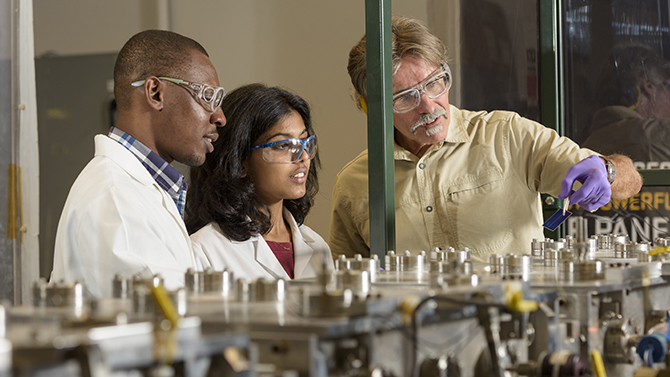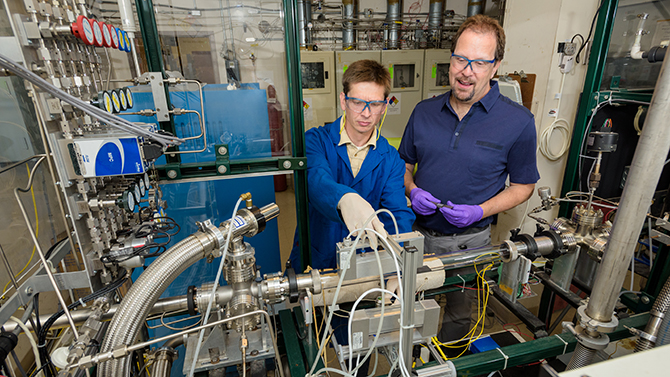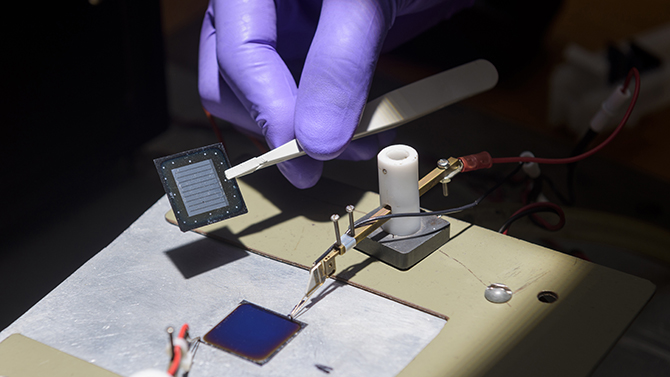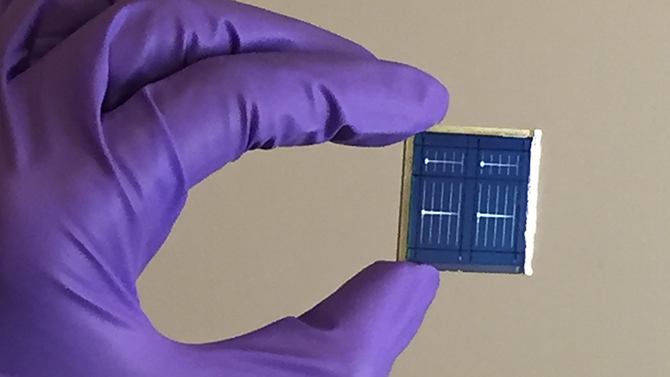


SunShot funding
Photos by Evan Krape and William Shafarman September 14, 2016
UD leads two solar projects funded by Energy Department’s SunShot Initiative
The University of Delaware’s Institute of Energy Conversion (IEC) has been awarded $2.1 million from the U.S. Department of Energy SunShot Initiative for two research projects aiming to improve the performance of solar cells while reducing their manufacturing cost.
Senior scientist Steven Hegedus will lead a three-year, $1.25 million project for work on the most efficient silicon solar cell to date, known as the interdigitated back contact (IBC) solar cell. All the metal contacts are on the non-illuminated (back) side of this silicon cell. This allows more light to be harvested in the cell because any shadowing from front-side grid lines, found in conventional solar cells, is eliminated.
Several companies have produced IBC cell designs with an efficiency of more than 25 percent, but the production costs for these solar cells are higher due to difficulties in patterning and isolating the positive and negative electrodes on the back of the solar cell, Hegedus explained.
Hegedus and his team, including Ujjwal Das, associate scientist at IEC, will explore the use of advanced laser patterning techniques to overcome these challenges. The project team will include the Laser Manufacturing Laboratory at the University of Virginia and Silevo, a leading manufacturer of high-efficiency silicon solar modules, based in Fremont, California.
“IEC has worked on an advanced type of IBC cell, and we have optimized some of the processing technology,” Hegedus said. “The complexity of the processing and its integration into manufacturing requires the multiple institutions we’ve assembled here.”
Senior scientist William Shafarman will lead a project team exploring new techniques for making solar cells from a compound material using copper, indium, gallium and selenium applied to a glass surface in layers up to 100 times thinner than a human hair. These thin-film solar cells can potentially be manufactured at much lower cost than the more conventional silicon solar cells.
“We need to keep making solar cells better and cheaper,” Shafarman said. “Our goal is to make higher-efficiency solar cells and to translate new materials and processing techniques into the large-scale manufacturing of photovoltaic modules.”
The three-year, $889,000 project will include Greg Hanket, associate scientist at IEC, and partners at the Molecular Foundry at the Lawrence Berkeley National Laboratory, who will assist with the advanced characterization of the materials used in the solar cells, and at Stion Corporation, a San Jose-based company that manufactures solar cells in California and in Mississippi.
“It’s great to see these SunShot Initiative projects coming to UD,” said IEC Director Robert Birkmire. “They will benefit our University community, industry, and the nation — and also involve our students in next-generation clean energy technologies.”
About the SunShot Initiative
The U.S. Department of Energy SunShot Initiative is a collaborative national effort that aggressively drives innovation to make solar energy fully cost-competitive with traditional energy sources before the end of the decade. Through SunShot, the Energy Department supports efforts by private companies, universities and national laboratories to drive down the cost of solar electricity to six cents per kilowatt-hour.
About the UD Institute of Energy Conversion
Founded at the University of Delaware in 1972, the Institute of Energy Conversion (IEC) develops the fundamental science and engineering base required to improve solar cell performance and processing technologies and then transfer lab results to large-scale manufacturing. In 1992, IEC was designated a Center of Excellence for Photovoltaic Research and Education by the U.S. Department of Energy. IEC is the oldest solar cell institution in the world and has produced more professionals in the field than any other U.S. university.
Evan Krape
Senior scientist William Shafarman (right) and associate scientist Greg Hanket use a novel hydride gas reactor to convert metal layers to the semiconductor film that forms the critical layer in a thin-film solar cell.
Evan Krape
Researchers from UD’s Institute of Energy Conversion will lead a three-year, $1.25 million project for work on the interdigitated back contact (IBC) solar cell, shown here. All the metal contacts are on the back of this solar cell (held in hand), which allows more light to be harvested on the front side (on table), as shadowing from the front-side grid lines found in conventional solar cells is eliminated.
Researchers from UD’s Institute of Energy Conversion also will lead a three-year, $889,000 project to explore new techniques for making thin-film solar cells like this one from a compound material using copper, indium, gallium and selenium applied to a glass surface in layers up to 100 times thinner than a human hair.
Contact Us
Have a UDaily story idea?
Contact us at ocm@udel.edu
Members of the press
Contact us at 302-831-NEWS or visit the Media Relations website




